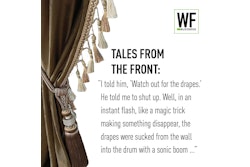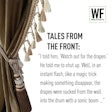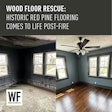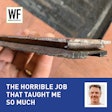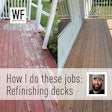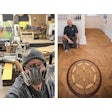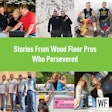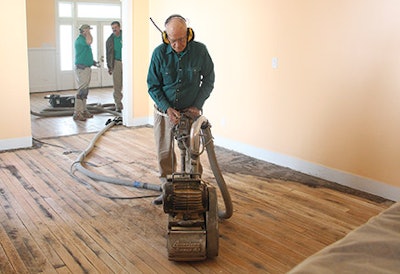
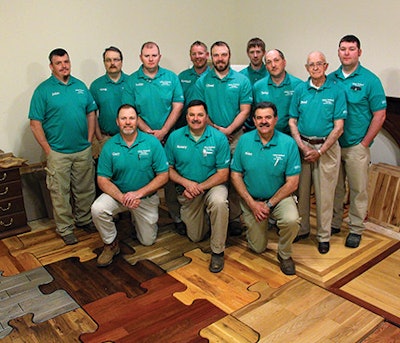
The men of Sullivan Hardwood Flooring dress sharp. They wear khaki-colored pants and polo shirts in an eye-catching green. The shirts have the name of the man who wears it and company name embroidered across the chest. Alan Sullivan, who owns the company along with his two brothers and father, let Hardwood Floors magazine tag along and spend the day with him on the Tuesday before the NWFA Expo. Throughout the day, it became clear that Sullivan Hardwood Floors’ professionalism isn’t just window dressing: The shirts and the clean look match the level of professionalism and respect the company brings to each job. They feel like the kind of guys you trust, and they proved it throughout the workday.
6:45 a.m.
Alan Sullivan arrives at the Sullivan Hardwood Flooring warehouse and showroom, located in Scottsville, Ky., about 25 miles southeast of Bowling Green and less than a half hour’s drive away from the Kentucky–Tennessee border. He’s wearing an Irish green polo shirt emblazoned with the Sullivan Hardwood Flooring name. It’s an eye-catcher—Sullivan is about 6-foot, 4-inches tall. That’s a lot of green.
 Alan Sullivan discusses the day’s projects with the staff.
Alan Sullivan discusses the day’s projects with the staff.
7 a.m.
The rest of the staff, 11 today, have arrived and are seated on chairs set up in a circle in front of the bulletin board in the warehouse. Like Alan, they all have their green shirts on. (Like Sullivan, they’re all of tall stock.) The uniform, Sullivan says later, helps build an atmosphere of trust with the customer. Some guys in the industry walk onto a job site looking raw, he says: “They don’t know how to present themselves.”
7:06 a.m.
The guys are shaking off sleep with soft chatter about the weather the night before and email scams. Sullivan, getting ready to start the daily morning meeting, clears his throat and takes control of the room, “All right guys, I have an email that says I’ve won $2.5 million, just contact us.”
7:19 a.m.
Like hardwood flooring, church is also a family business. In the 1980s, Sullivan toured with a gospel singing group on weekends. Two of his brothers, along with the office manager and another employee, are ordained pastors. The day always starts out with a group prayer. Today, Sullivan’s brother Gary leads the prayer. The whole team goes quiet and bows their head in reverence. After he finishes, he opens the floor to anyone else who would like to pray. There are a number who do, and they take turns voicing their wishes and worries, including a relative’s heart issues and the Ukraine-Russia conflict.
 Alan talks with his brother Kenny
Alan talks with his brother Kenny
There is little shyness here. Most of the men on staff are related somehow, but blood doesn’t prejudice anyone’s concern for each other. Alan cares for each worker like family, he says. “It’s never been about how much will I have at the end of the year,” Alan says. “This has been about providing a viable place to provide for their families.”
After the prayers, Alan goes over the day’s projects and splits the staff into teams. He tells each team what equipment they’ll take and which truck or trailer they’ll drive to the project site. The majority of the business‚ about 90 percent, is sanding and finishing floors.
The guys get their assignments and ready the trucks. They would normally head right out, but today is different: A reporter is in the building with a camera, so the guys hang around to wait for the company’s 12th man, Sullivan’s father Paul, to take a group picture.
7:43 a.m.
Paul Sullivan—everyone at Sullivan Hardwood Flooring calls him “Pa,” whether family or not—arrives. He’s wearing the same Irish green polo as everyone else. The shirt color was actually Paul’s idea—it’s his favorite color. With their team all there now, the group of guys file into the showroom, line up and smile for the camera.
Paul, at 78 years young, is a legend at Sullivan Hardwood Flooring. He started a company working on wood floors in Annapolis, Ind., in 1957. He sold the business in 1974 and moved to Allen County, Ky., in 1975, where he found full-time work at a General Electric plant. After his shifts, he continued to work on hardwood floors with his son Mark Sullivan. Alan and Gary, also working at GE at the time, would help their dad and brother occasionally. To put that into perspective, Paul and his sons would work full shifts at GE during the day and work floors until as late as 11:30 p.m. They didn’t even stop home for supper in between. “We grabbed something to eat on the way there,” Alan says. It was hard, sleep-depriving work.
It went on like that for much of the early 90s, until Alan heard a visiting pastor’s sermon at church. As Alan remembers it, the pastor told his audience to let go of their security blanket. Two days later, that’s what Alan did. He quit GE and started a flooring business. Paul and Gary followed suit a year later and joined Alan in what became, with the inclusion of brother Kenny, a burgeoning family business.
With the group photo done, the guys of Sullivan Hardwood Flooring file out to their trucks and start the work day.
8:13 a.m.
Alan Sullivan checks in on his son, recent Western Kentucky University graduate Josh Sullivan, who is on the computer working on the company’s website and social media feeds. Sullivan Hardwood Floors has a YouTube channel, Pinterest board, Houzz profile and Facebook page.
8:41 a.m.
 A customer phones Alan to ask if he can repair her floors after another company botched them.
A customer phones Alan to ask if he can repair her floors after another company botched them.
Alan takes a call in his office from a woman unhappy with the refinish job she received recently. She isn’t calling to cuss Alan out, but to request the company’s services. She tells Alan that, despite knowing better, she chose a contractor to refinish her floors solely because he charged less. There was noticeable dust leftover in the new finish. You can hear her disappointed voice coming through the phone receiver, “I don’t want them back in the house.”
What sets Sullivan Hardwood Flooring apart from the competition—and why the woman called Alan to fix her floors—is not just the quality of craftsmanship it brings, it’s the trustworthiness of its employees. Customers would never say that they didn’t want a Sullivan employee back in their houses, Alan says. In fact, the men of Sullivan Hardwood Flooring are trusted to turn on vacationing customers’ Christmas lights at night. He keeps that in mind for new hires: “If we can’t trust you, then I don’t need you. People have given us the keys and gone on vacation. Anyone you’ve seen here, each guy, you wouldn’t mind them coming into your own house.”
9:04 a.m.
After all the crews are out in the morning, Alan typically speaks with Terry Howser, office manager and the numbers guy, to get the list of estimates Alan is scheduled to do that day. With their constant business, he’s sometimes out until 6 p.m. completing estimates. Alan says the company usually fills its calendar three to six months in advance.
The woman who called Alan about the refinishing job hit this point on its head. Alan had told her he wouldn’t be able to repair her floors for a while because they were booked. She responded: “Oh, I know... I don’t call [Sullivan Hardwood Flooring] near Christmas because they’re full; don’t call them in spring because they’re full. I’ve learned to call you early.”
10:31 a.m.
 Alan sands a Brazilian cherry panel
Alan sands a Brazilian cherry panel
Alan receives a call from a homeowner who is unhappy with the floor that came with the home he recently purchased. The floor is solid Brazilian cherry, and the homeowner tells Alan he doesn’t like the color. He tells Alan he was thinking about a weathered gray stain.
It’s not often a customer wants to see a gray stain on Brazilian cherry, so Alan has to assemble a sample. He goes into the warehouse to get to work. Alan finds a few planks of Brazilian cherry and cuts them down to size with a table saw to make a 23-by23-inch sample. He uses a pneumatic nailer to secure the planks to a mock subfloor, sands them with an edger and mixes a custom gray stain. He’ll show the panel to the customer later in the week.
11:38 a.m.
Alan eats lunch at a McDonalds in town before hitting the road toward Bowling Green to check up on his project teams.
12:34 p.m.
Alan stops at a house in Bowling Green where his brother Kenny is leading a team of guys as they install a floor. The brothers discuss an issue in the bathroom—water has leaked by a vent in the floor—before Alan leaves to follow up with a nearby customer.
1:40 p.m.
Alan enters the house of a customer who had his floors repaired and refinished after a major water accident. Alan is visiting to do some “public relations.” The company’s business, the bulk of it, comes from word of mouth. Seeing that the customer is happy with the job after they’ve moved furniture back on to the floor is one way to boost referrals. Minus a spot on a local Christian radio station, the company doesn’t advertise. “We don’t have to,” Alan says.
Weeks earlier, the floors on the ground floor of the house were in bad shape. A water line froze and broke in the floor between the ground and first levels, causing the ceiling to swell and eventually fail. Water ran freely onto the solid hardwood flooring below until the family came home and turned it off—luckily before the whole floor was flooded. Most of the damage was restricted to the family room, dining room and kitchen. They had to replace 100 square feet, but, despite the deluge, the company was able to save a majority of the floor.
Alan says he did an estimate at a different house for a similar repair—water main break, severely damaged hardwood floors. The client told him another contractor said the repair would require replacing the floor. The cabinetry would have to be removed, to boot. Alan poked around with his moisture meter and told the customer that he didn’t have to do any of that. “I told him, ‘Your floor will lay back down if you hire a company to dry it out.’”
 The Donoho Hotel’s floors show a variety of species
The Donoho Hotel’s floors show a variety of species
 Paul Sullivan’s drum sander.
Paul Sullivan’s drum sander.
 Paul Sullivan, Alan’s 78-year-old father, prefers drum sanders. Here he sands years’ worth of grime off the Donoho Hotel floors with an American Super 83.
Paul Sullivan, Alan’s 78-year-old father, prefers drum sanders. Here he sands years’ worth of grime off the Donoho Hotel floors with an American Super 83.
Alan knew because he has done his own experiment: He, too, had a water line break in his own home. He decided to see how much the wood would move if he gave the floor time to dry out. The planks eventually flattened into place.
Today, the floor at the house where the ceiling caved in looks great. Alan’s guys were able to repair the floor and changed only six boards. The customer, realizing he saved money, asked for something extra—a gray stain, one that looked like a floor his wife had seen at a friend’s.
As Alan was looking at the floor, the customer had to leave. He said goodbye to Alan and asked him to make sure the doors were locked after he finished.
3:07 p.m.
Alan drives an hour away, out of Kentucky and into Tennessee, arriving at a historic hotel in Red Boiling Springs. The town, population about 1,100, became a tourist attraction in the 1870s. A stagecoach line connected it to a railroad in nearby Gallatin that ran into Nashville. In subsequent decades, the town’s tourism industry boomed around the area’s springs of red-colored sulphur water. Entrepreneurs built a number of grand hotels. Alan pulls his truck up to one of these hotels, still standing just two years shy of its centennial anniversary, called the Donoho Hotel.
Gary and Paul have been inside working on the Donoho’s floors all day. In fact, the Sullivan Hardwood Flooring company has been working to refinish the Donoho floors on and off for two weeks.
The hotel, built during the resort boom in 1916, features full-length, two-story verandas, a large entrance hall, lounge room and a dining room. There is solid wood flooring throughout, and the species varies from board to board. Alan points out planks made from beech, maple, ash and oak trees. Some of the boards came from trees with termites.
Most of the hotel floor has already been refinished. Alan says they used one coat of tung oil and topped it with a coat of polyurethane. The finished rooms, paired with the bright wall paint chosen by the hotel’s new manager, look immaculate.
Paul says people told him that those floors could not be finished because they’d never been refinished before—nonsense. The team has already finished nine bedrooms, a big hallway upstairs, the stair steps, and a big living room and hallway on the ground level. Today, Paul, nearing his 80s, is sanding a thick coat of grime off the floors in the ground-level lounge with a 16-grit open coat on an American Super 83 big machine. “He’d rather run a drum sander than a belt sander,” Alan says.
5:38 p.m.
Alan helps his dad and brother pack up the equipment from the Donoho and makes the hour-long drive back home to Scottsville.

















